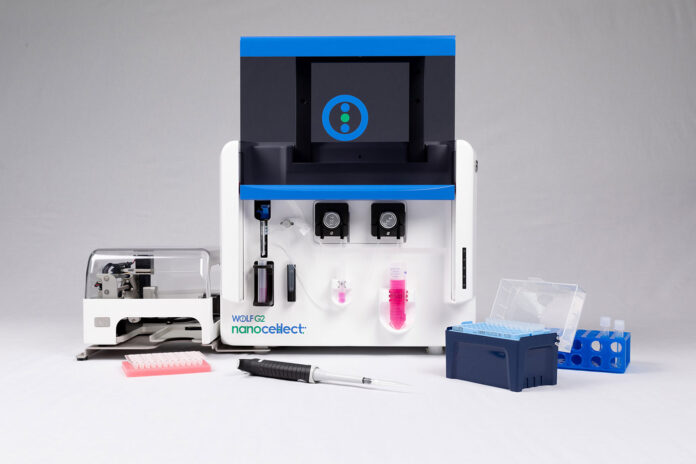Sponsored content brought to you by
Many increasingly used applications, such as cell line engineering and sequencing (including ATAC-seq and RNA-seq) along with single-cell genomics, require single-cell isolation as a starting point. But the cost and complexity of cell sorters have traditionally relegated this technology to larger lab groups or core facilities.
NanoCellect is changing that paradigm by facilitating portable, affordable, and easy-to-use cell sorting and analysis technology that researchers are embracing. For instance, Justin Chartron, PhD, Protein Engineering Scientist, Protabit, emphasizes that WOLF Cell Sorters is a technology that enables small companies to do things they could not do before.
Accessible and Maintenance-Free
NanoCellect’s WOLF and WOLF G2 Cell Sorters use a disposable, aerosol-free microfluidic cartridge to not only provide a sterile closed system for sterile sorting but also to eliminate cross-contamination and aerosols as well as fluidics from inside the instrument. The bonus is a maintenance-free instrument for sorting live cells.
At <2 psi, the low pressure systems are gentler than conventional cell sorters, enabling healthier cells post-sort, especially for engineered cell lines, primary cells, stem cells, and fragile plant cells such as protoplasts without cell walls. Peristaltic pumps along with a low-voltage piezoelectric actuator accurately sort cells into two chambers. Add-ons include the N1 Single-Cell Dispenser. It dispenses single cells directly into 96- or 384-well plates, including PCR plates, to simplify the workflow.
“Neurons are extremely delicate, so the selection step should be the least disturbing of all if we want to have reliable results,” says Dorota Skowronska-Krawczyk, PhD, Assistant Professor, University of California, Irvine. “When we tried the WOLF, we were extremely surprised that our cells were healthy and that viability was above 90%—sometimes above 95%, which is impressive.”
Facilitating Cell Line Engineering
Monoclonal cells are used in many cell line engineering workflows. Traditional methods of single-cell cloning such as limiting dilution are time-consuming, slow with low-throughput, and require expansion to identify desirable cell candidates. Plus, several rounds of cloning are needed since limiting dilution can result in more than one cell per well.
To support cell line development, a WOLF Cell Sorter and the N1 Single-Cell Dispenser constitute an efficient, alternative means of screening millions of cells and specifically sorting and dispensing single cells of interest. For example, the WOLF G2 was used to sort GFP+ HEK293 cells stained with DRAQ7 to fully exclude dead cells. Also when the WOLF was used to sort cells without a viability dye, an average total outgrowth of 74±2.9% to 78±5.5% was generated.
Powering Genomic Analyses
The increasing availability of microfluidic and single-cell genomic tools allows continued dissection and expansion of current knowledge of cellular biology. Unfortunately, most labs lack adequate tools to properly isolate single cells and dispense them into 96- or 384-well plates. Often, these laboratories also do not have the capacity to develop a complex RNA-seq or ATAC-seq protocol.
To demonstrate the prowess of the WOLF Cell Sorters, first, a cell population was sorted to dramatically reduce the dead cell/debris population. The resultant healthy CHO cells were then dispensed into 96-well cell culture plates. Efficiency analysis using the Synentec NyOne imager showed that the WOLF’s N1 Single-Cell Dispenser efficiency on 96-well plates averaged 85%, validating the ability of the platform to sort cells gently without causing cell death.
No significant difference was seen when sorting directly into a PCR plate. In this scenario, the number of gene transcripts that were detected from each well was used to determine single-cell efficiency. The results showed that the N1 is able to successfully plate a single cell into a PCR plate and produce results for single-cell RNA-seq and confirmed that the WOLF and N1 platforms are compatible with the Qiagen UPX 3’ transcriptome kit. Together, these two platforms generate accurate, robust results in a simplified approach.

Learn More hubs.ly/Q025F5St0




